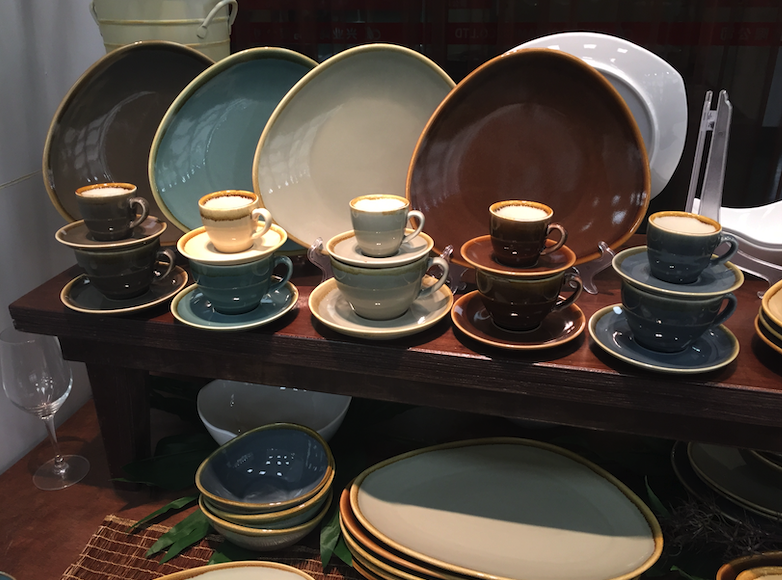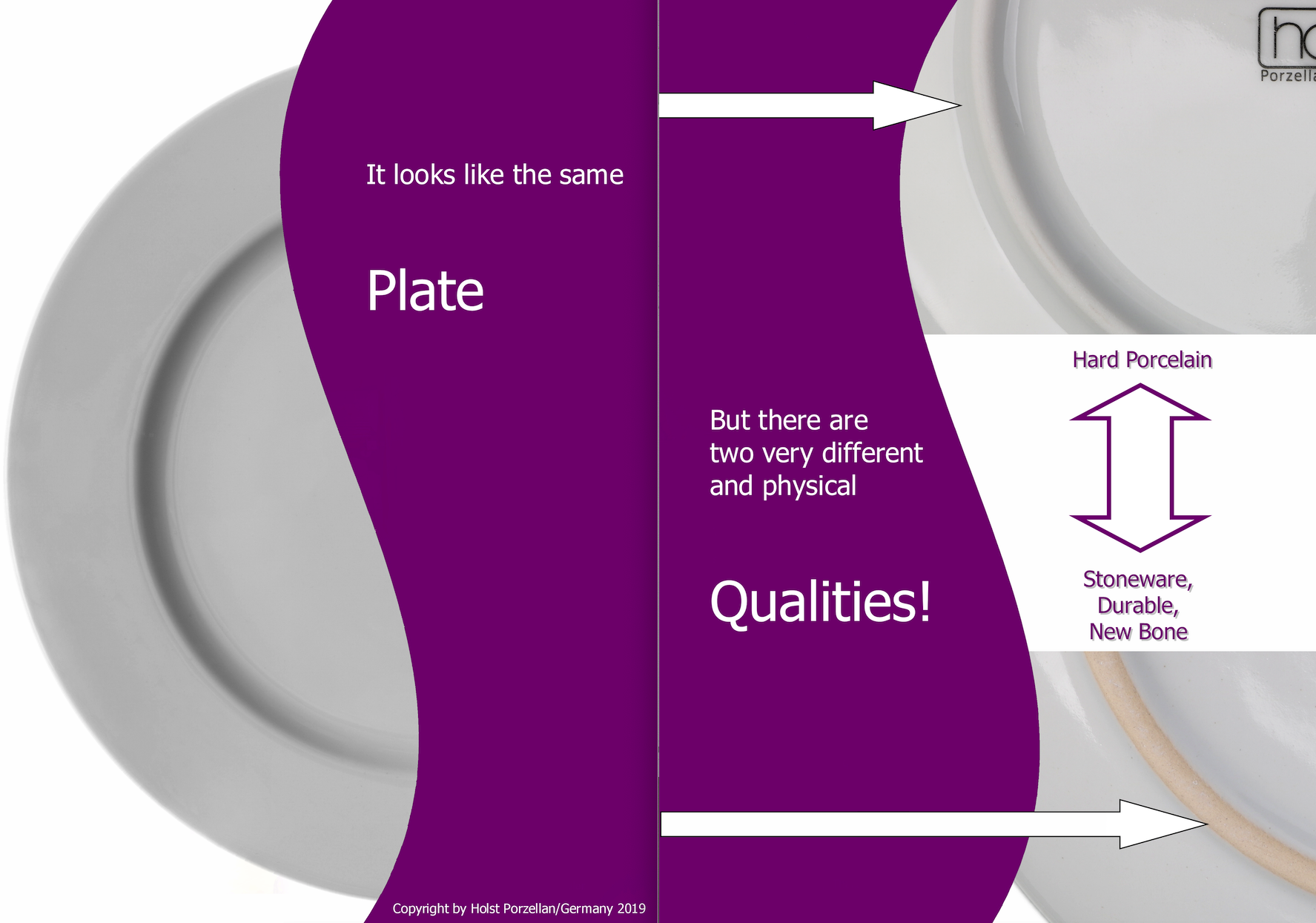Crockery

This page is still under construction (wv-kh)
Crockery - one of the Oldest Ceramic Types
Crockery - like stoneware and porcelain - is of course also part of the large group of ceramics. The layman can easily confuse crockery with porcelain in a pure colour comparison, because its body colour is very similar to the white of porcelain. In terms of the lustre of the glaze, crockery is also very similar to porcelain. Most of the time, however, the body of the crockery is thicker and clumsier than that of the porcelain because it lacks density. The body of the crockery is permeable to water and porous and does not allow light to pass through. Only when the glaze is applied does the body of the stoneware become impermeable, allowing it to come into contact with food.
The usual hardness of the cullet is about 3 - 4 Mohs. This means that crockery from steel - i.e. cutlery - can be easily scored. This is due to a special feature of crockery. With crockery, the firing temperature of the body in the biscuit firing (approx. 1,300 °C) is higher than that of the glaze firing (approx. 1,100 °C).
Why is there crockery at all?
Please allow us - as a porcelain manufacturer - to abbreviate and compress this subject area, otherwise this contribution would be 5 times as extensive. Crockery itself is already divided into three groups.
- Calcite stoneware (soft stoneware low fired)
- Feldspathic earthenware (hard stoneware)
- Mixed stoneware (a little of both)
The basic mass of the body consists of a mixture of white-firing clay, feldspar, chalk, quartz and pegmatite and differs from the higher quality porcelain already by its composition. As a rule of thumb, crockery consists of 50% plastic and 50% stabilizing components. This composition results in a formability and stability during the first firing that is superior to porcelain. This explains why there are mainly large plates and bowls made of crockery that would not succeed in porcelain in the kiln. A large proportion of sanitary ceramics is also made from this raw material mix. Crockery therefore has its justification due to its high malleability.
Due to the - very unique - biscuit firing method shown in the upper paragraph, the body is virtually sintered through, i.e. basically finished before it is glazed. The lower glaze firing at approx. 1,100 °C allows the use of many more colours or finishing techniques than with reactive or oxidising glaze. Due to the high firing temperature of the porcelain (> 1,320 °C), the range of colours and decorations in crockery is much higher, brighter and more intensive. On the other hand, this circumstance explains a different expansion of glaze and body under thermal stress, which in turn favours the formation of chraquel cracks.
Crockery in the Gastronomy
In our experience and opinion, crockery has no place in commercial catering - i.e. in the hotel and catering industry and especially in hospitals and communal catering! Crockery glazes traditionally contain lead oxide, mennins and lead white, boric acid soda and potash. Thanks to the FDA and LFGB, legal limits have now been set so that the proportion of tableware with harmful emissions has virtually disappeared from the market. Nevertheless, we still come across imports of stoneware that do not comply with the legal requirements. Occasionally, such incidents also make it into the press (google "Dishes recall").
Apart from the risk of possible emissions, the fact remains that the glaze is soft. The fact of the low temperature of the glaze firing alone (max. 1,100 °C) denies the earthenware any kind of cut resistance or resistance to glaze corrosion. The consequences of commercial warewashing and the associated chemical exposure are initially small, almost invisible cracks in the chraquel, which already lead to a loss of hygienic stability and thus make the ware unusable for commercial use.
In addition to the lower hardness of the glaze, the less dense, more porous shards also stand for limited commercial usability. Even a slight edge impact is sufficient to damage or break the stone glaze.
Crockery has never been produced with the aim of commercial use. In our opinion, the use of stoneware in the catering industry can be attributed to two main factors.
The Price Factor
Import duties for porcelain are 12%, whereas those for crockery are only 5.5 to 6%. This difference in customs duties results in an artificial shift of "the market price" to the disadvantage of porcelain. The price advantage of crockery is further increased by the lower firing costs and the lower value of the raw material. Thus, price differences of 30% and more quickly come together.

If the articles now look similar to the picture above, the purchase decision is naturally made by the price difference.
The Taste Factor
It is unfortunately true that crockery can be used to create more beautiful decorations, richer colours and above all modern trends such as reactive glazes. We also understand the gastronomy's desire to stand out from the rest through the language of shapes, innovative serving elements and trendy colours. But just as a "caddy" cannot be realised as an aerodynamic sports car, the possibilities are limited in form and colour with porcelain.
From our point of view, however, the use of crockery in the trade is a breach of professional rules, just like the use of coloured bed linen in a hotel room or an unfolded towel in a guest bathroom. Even after a short period of use, cut marks and glaze corrosion lead to a loss of hygienic properties. Such a plate must definitely not be served to a guest any more.
Crockery by Holst Porzellan
Until the mid-1980s we still carried high-quality stoneware of the brand Pfalzkeramik (Winterling Bruchmühlbach). These collections, produced exclusively for private consumers, included fashionable ceramics, summer decorations, country house service and similar entertaining trends. As a result of the collapse of the Winterling Group in the early 1990s, and due to our concentration on the commercial tableware sector, we parted with this crockery in our own range in order to concentrate entirely on commercially usable porcelain. We have crockery produced in partner plants in Asia today on request within the framework of our OEM business for retailers, supermarkets and discounters.
Note: For a better differentiation of the ceramic types, please also read our article: Quality classes of ceramics.
